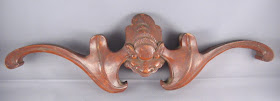With its gauzy blue wings and glittery details, the above Chinese bat is perhaps the most delicate and pretty one that I have seen. Since Halloween is coming up, with its frightening images of attacking vampire bats, I thought this would be a good time to compare Eastern and Western bats.
 |
| "I want to suck your blood...." |
In Chinese culture, bats have a positive symbolism, and are considered to bring good luck, because the Chinese word for bat (fu,蝠) resembles the one for luck (fu,福) and is also written similarly. Here are a couple of good-luck bats that are meant to be hung in the home, one in wood, and the other in gilt bronze. (Neither of these is very old; in future posts, I plan to examine how bats were incorporated into antique and vintage items.)
 |
| Bats are very auspicious commercially, as in this sign for “One Luck” take-out food. |
If these outlines of Chinese bats are starting to look familiar, that is because bat-shaped hardware was borrowed by the heavily Chinese-influenced furniture designer Thomas Chippendale. Once you see this connection, a lot of Chinese-inspired scroll-work will resolve itself into bat-forms. Here are a couple of bonnet-top high chests from the Boston Museum of Fine Arts which incorporate Chinese Chippendale drawer-pulls and other brasses.
 |
| An Eighteenth-century Massachusetts high chest. |
 |
| Detail of Massachusetts chest. |
 |
| Another high chest, this one by famed Newport cabinetmaker John Townsend, c.1750’s. |
 |
| Detail of Townsend chest. |
Bats are truly ubiquitous here in Taiwan. They are found in good-luck charms, jewelry, home furnishings, stationery—just about anywhere. Taking a look around my apartment, I noticed a bat motif in the tile floor of the balcony, which has a repeating design of four bats facing inward in a circle:
 |
| The corners of my coffee table are enhanced with carved bats. |
Here is an especially festive and friendly bat that adds an additional good-luck element to a New Year’s decorative firecracker.
So now that you have compared both types, which bats do you prefer: auspicious, friendly, attractive Chinese ones, or dreadful, unlucky, ominous Western ones?
 |
| One more look at a scary Western bat. |
=====================================================================
Photo credits: The two high chests are courtesy of the Boston Museum of Fine Arts, www.mfa.org. All other images belong to the author.













